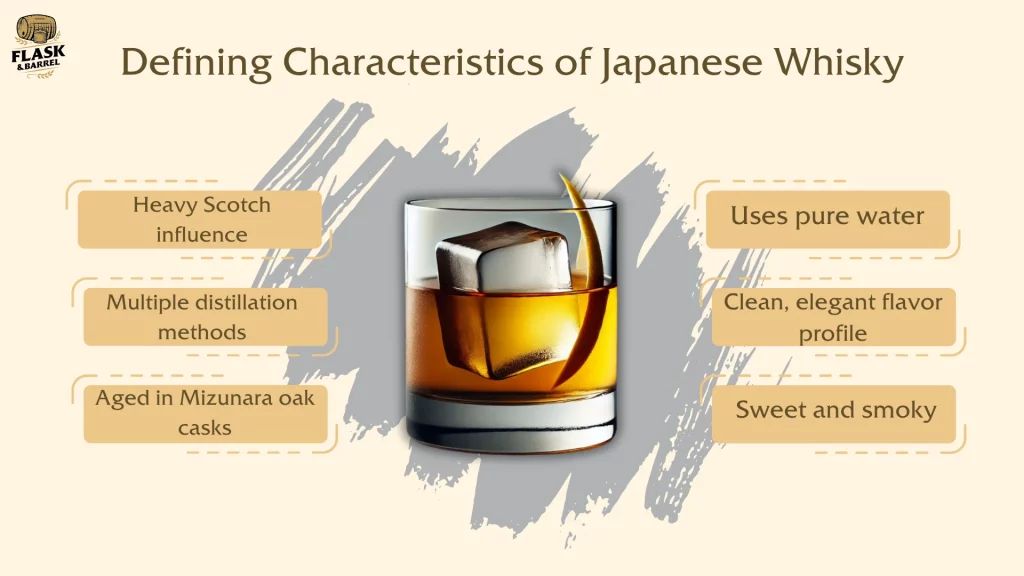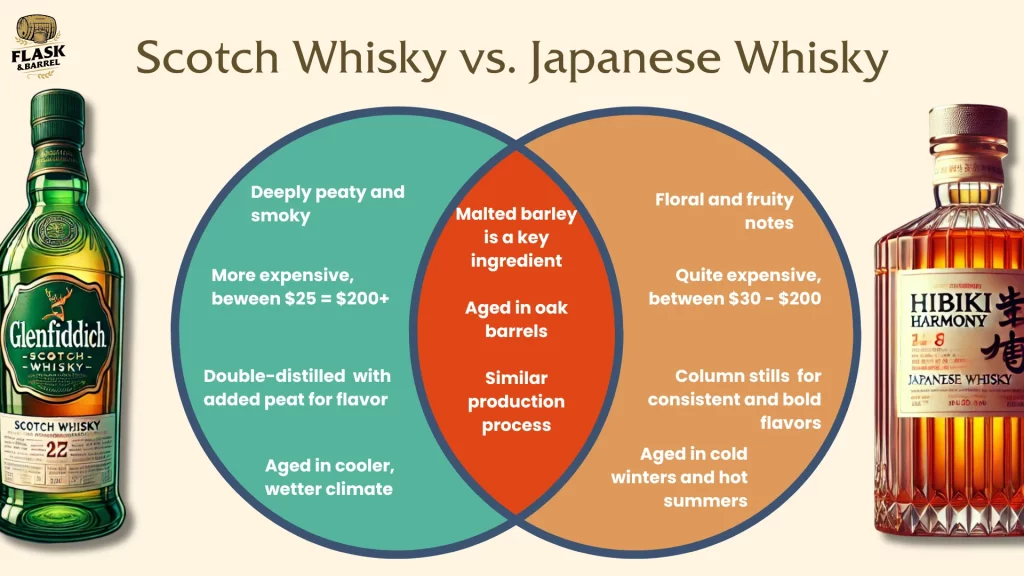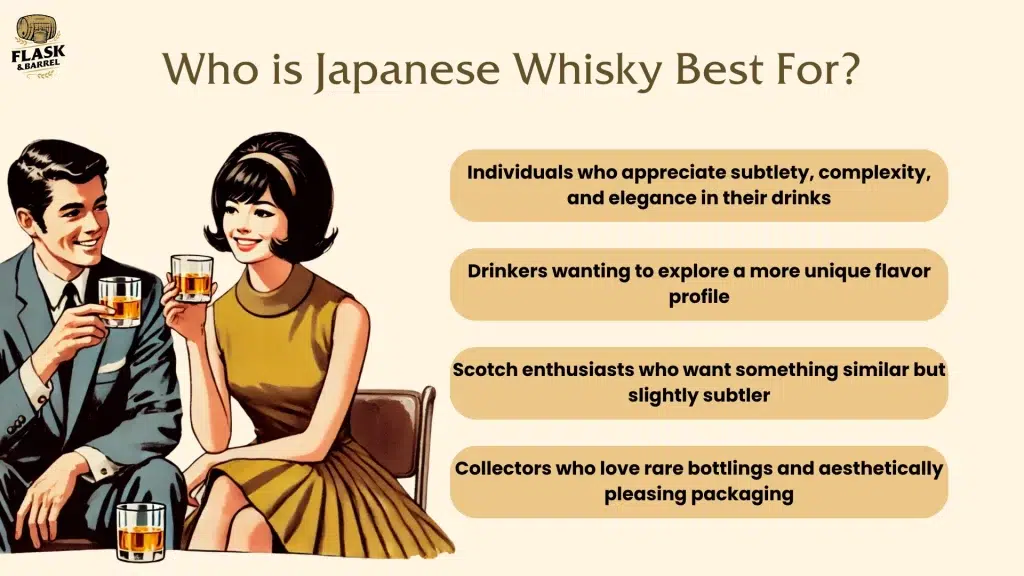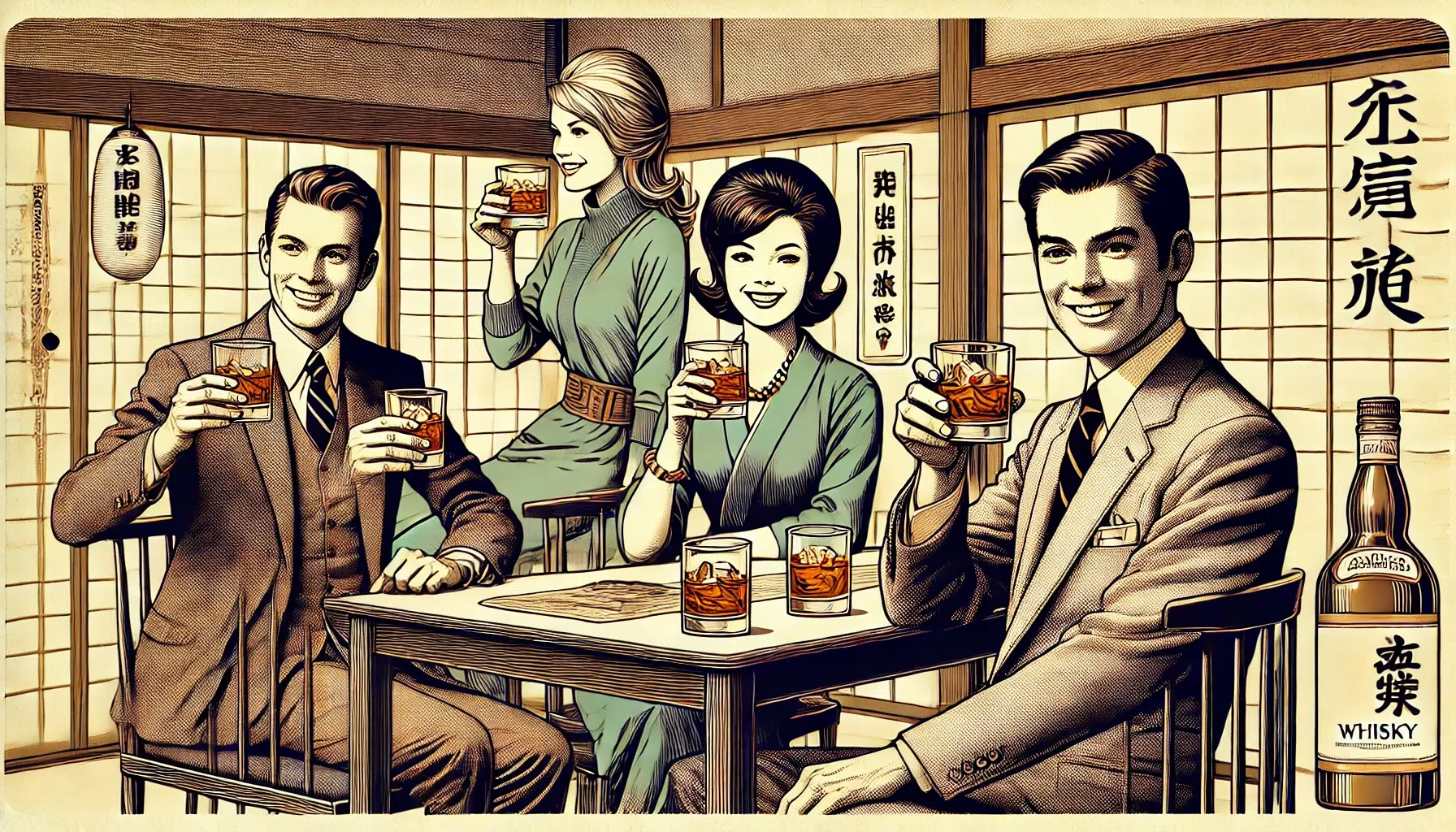Comparing Japanese whisky to Scotch whisky is like exploring two worlds of flavor and craftsmanship. Japanese whisky brings a fresh, elegant twist, while Scotch whisky is steeped in rich tradition and diverse tastes. Both offer something special, from their unique production methods to their cultural significance. Dive in with us to see what makes each of these whiskies stand out and why they both deserve a spot on your shelf.
The Defining Characteristics of Japanese Whisky
Japanese whisky is celebrated for its precision, balance, and a meticulous approach to distillation and aging. Embracing a philosophy that values harmony and subtlety, these whiskies are known for their refined smoothness, making them exceptionally approachable. The utilization of pristine water sources and a variety of cask types for aging imbues Japanese whisky with a broad spectrum of flavors.

These range from delicate floral and fruity notes to deeper, umami-rich profiles. Distilleries across Japan, each with their unique methods and environmental conditions, contribute to the complexity of the whisky, producing expressions that are both distinct and diverse. For instance, Yamazaki and Hakushu distilleries, known for their Single Malt whiskies, often utilize Mizunara oak casks for aging, which impart a distinctive spicy and incense-like flavor to the whisky.
Similarly, Nikka’s Yoichi Single Malt showcases a slightly peaty and rich character, a testament to the distillery’s coastal location and use of traditional coal-fired stills. This unwavering commitment to craftsmanship and the pursuit of perfection stand as the defining hallmarks of Japanese whisky, setting it distinctly apart in the global whisky landscape. The Mizunara oak, a rare and indigenous wood to Japan, is particularly noteworthy for its contribution to the unique flavor profile of Japanese whisky, adding notes of sandalwood, coconut, and exotic spices, further enriching the complexity and allure of these esteemed spirits.
The Defining Characteristics of Scotch Whisky
Scotch whisky stands as a testament to depth and diversity, deeply entrenched in centuries of tradition and the distinctive terroirs of Scotland. Its character is largely defined by the regional variations that sculpt its flavor profiles, ranging from the peaty, smoky nuances of Islay to the light, floral notes of the Highlands. For example, Laphroaig from Islay is renowned for its intensely peaty and smoky flavor, while Glenmorangie from the Highlands offers a more floral and fruity profile.

The cornerstone of its uniqueness lies in the use of malted barley and a steadfast commitment to traditional distillation practices, including the iconic copper pot stills. The use of peat in the malting process is a practice particularly associated with Scotch whisky, especially those from Islay. This process involves drying malted barley over peat fires, imparting a distinctive smoky flavor to the whisky.
A mandatory aging process in oak barrels for at least three years allows for a complex evolution of flavors, spanning vanilla, toffee, dark fruit, and spice. Scotch is categorized into several types, including Single Malt, Blended, and Grain Whisky, each offering a unique window into the rich tapestry of Scotch whisky flavors. This classification not only underscores its variety but also invites enthusiasts to delve into a spectrum of tasting experiences.
The enduring heritage and unwavering dedication to quality have solidified Scotch whisky’s position as a globally revered spirit, celebrated for its rich palette of flavors and storied past.
In What Ways Are They Similar?
Japanese whisky and Scotch whisky are united by their dedication to the art of whisky making, with both traditions prioritizing the intricate balance of flavors and a profound respect for the distillation process. Central to both is the use of malted barley as a key ingredient, and the aging in oak barrels plays a pivotal role in developing their complex and nuanced flavor profiles. Furthermore, each adheres to stringent production standards, ensuring a consistently high level of quality and craftsmanship.
This shared ethos of excellence and tradition has elevated both Japanese and Scotch whisky to the global stage, captivating whisky enthusiasts who value the depth of flavor and the meticulous process behind their creation. Comparative analysis reveals that both Japanese and Scotch whiskies undergo similar stages of production, including malting, where barley is soaked, germinated, and dried; fermentation, where yeast is added to convert sugars to alcohol; and distillation, where the alcohol is purified and concentrated. Both traditions also involve aging the distilled spirit in oak barrels, which significantly influences the final flavor profile.
Examples of shared standards or certifications include the Scotch Whisky Association’s regulations for Scotch, which dictate production methods, aging, and labeling, and the Japan Spirits & Liqueurs Makers Association’s standards for Japanese whisky, introduced in 2021, which align more closely with Scotch whisky standards to ensure quality and authenticity. These guidelines include stipulations on the geographical production area, the use of malted grains, and the aging process in wooden casks, underscoring a mutual commitment to maintaining the integrity and heritage of each whisky tradition.

In What Ways Are They Different?
Japanese whisky and Scotch whisky, while both steeped in tradition and craftsmanship, diverge in their flavor profiles and production nuances, reflecting their unique cultural backgrounds. Japanese whisky is celebrated for its pursuit of harmony and balance, often yielding a cleaner, more refined palate with subtle complexities and a smoother finish. For example, a typical Japanese whisky like Yamazaki 12 Year Old might offer a palate of honey, fruit, and a hint of smoke, showcasing the subtlety and elegance that Japanese whiskies are known for.
This stands in contrast to Scotch whisky, which boasts robust diversity and strong regional characteristics, from the peaty, smoky flavors of Islay, as found in Laphroaig 10 Year Old, to the fruity, floral notes of Speyside, exemplified by Glenfiddich 12 Year Old. The climate in Japan also plays a pivotal role, influencing the maturation process differently than the cooler, more consistent climate of Scotland, often leading to an accelerated aging process that imparts unique environmental nuances to the flavor profile. Japan’s varying climates, from the northern cold of Hokkaido to the southern warmth of Kyushu, can significantly affect the maturation rate and flavor concentration, whereas Scotland’s generally cooler, maritime climate provides a more uniform maturation process across its distilling regions.
Moreover, Japanese distilleries frequently experiment with a variety of still types and barrel woods, showcasing a willingness to innovate within the bounds of tradition. For instance, the use of Mizunara oak for aging some Japanese whiskies imparts distinctive coconut and spice notes, which are less commonly found in Scotch whiskies. Conversely, Scotch whisky production tends to adhere more closely to time-honored methods, particularly in the use of copper pot stills and specific barrel types for aging, such as ex-bourbon and sherry casks, which contribute to the rich diversity of flavors that Scotch whisky is celebrated for.
Comparing Japanese Whisky and Scotch Whisky
Comparing Their Flavor
| Japanese Whisky Flavor Profile | Scotch Whisky Flavor Profile |
|---|---|
| Floral and fruity | Intense peat and smoke |
| Subtly peaty | Sweet, light nuances |
| Smooth and elegant | Broad spectrum of flavors |
Comparing Their Price Range
| Whisky Type | Price Range (USD) | Examples |
|---|---|---|
| Japanese Whisky | $50 – $500+ | Yamazaki 12 Year ($120 – $150), Hibiki Harmony ($100 – $140) |
| Scotch Whisky | $30 – $3000+ | Glenfiddich 12 Year ($50 – $70), Macallan 18 Year ($250 – $300) |
Comparing Their Distillation Process
| Feature | Japanese Whisky | Scotch Whisky |
|---|---|---|
| Still Shape | Varied, including pot and column stills | Predominantly copper pot stills |
| Aging Conditions | Experimentation with various cask types | Traditional, mainly oak barrels |
| Innovation | High, with a focus on refining and experimenting | Traditional, with adherence to long-standing practices |
Comparing Their Popularity
| Year | Japanese Whisky Sales Growth | Scotch Whisky Sales Growth |
|---|---|---|
| 2019 | +20% | +3% |
| 2020 | +15% | +2.5% |
| 2021 | +22% | +4% |
Comparing Their Critical Acclaim
| Award/Competition | Japanese Whisky | Scotch Whisky |
|---|---|---|
| World Whiskies Awards 2020 | Multiple winners including Yamazaki | Multiple winners including Glenfiddich |
| International Spirits Challenge 2020 | Hibiki 21 Year: Trophy Winner | The Macallan Sherry Oak 18 Years Old: Gold |
| San Francisco World Spirits Competition 2020 | Nikka Taketsuru Pure Malt: Double Gold | Ardbeg Uigeadail: Double Gold |
Who Is Japanese Whisky Best For?
Japanese whisky is the perfect choice for those who value elegance and subtlety in their spirits. Its smooth and refined character appeals to both newcomers to the world of whisky and seasoned enthusiasts seeking a nuanced drinking experience. Individuals with a preference for delicate flavors, such as floral and fruity notes, will particularly enjoy Japanese whisky.

Moreover, collectors and aficionados who appreciate innovation and craftsmanship in the distillation and aging processes will find Japanese whisky’s unique offerings irresistible. Its growing popularity and limited production also make it a sought-after commodity for those looking to add rare and exclusive bottles to their collections.
Profiles of Typical Consumers
- Newcomers: Ideal for those new to whisky, seeking a gentle introduction with smoother, more approachable flavors.
- Seasoned Enthusiasts: Offers complexity and nuance that reward the experienced palate, with subtle layers of flavors to explore.
- Collectors: With limited editions and unique expressions, Japanese whisky represents a valuable addition to any collection.
- Culinary Adventurers: Perfect for pairing with a wide range of foods, enhancing the dining experience with its versatility.
Recommendations for Introductory Japanese Whiskies
- For Newcomers: Yamazaki 12 Year Old – A perfect introduction with its rich fruitiness and elegance.
- For Seasoned Enthusiasts: Hakushu 18 Year Old – Offers a more complex, smoky flavor profile that challenges and satisfies.
- For Collectors: Karuizawa 1981 Vintage – A rare find that represents the pinnacle of Japanese whisky craftsmanship.
- For Culinary Pairings: Nikka Coffey Grain – Its sweet and vibrant profile complements a wide array of dishes.
By catering to a broad spectrum of tastes and interests, Japanese whisky offers something truly special for every type of whisky drinker, from the casual to the connoisseur.
Who Is Scotch Whisky Best For?
Scotch whisky is ideally suited for a wide spectrum of drinkers, from novices curious about its rich heritage to connoisseurs who revel in its complexity and diversity. Those with an adventurous palate, eager to navigate the extensive range of flavors from smoky and peaty to light and floral, will find Scotch whisky particularly engaging. Its profound regional variations provide a fascinating exploration of taste, perfect for those interested in understanding how terroir influences whisky.

For those seeking guidance on selecting Scotch based on flavor preferences or experience level, consider the following:
- For beginners: Look for Speyside or Highland whiskies, which are generally more approachable, with fruitier and floral notes.
- For the peat-curious: Start with a lightly peated Islay whisky to experience the smoky character without overwhelming the senses.
- For connoisseurs: Explore single cask or cask strength expressions from various regions to appreciate the full spectrum of flavors and complexities.
Examples of Scotch whiskies that cater to a wide range of palates and occasions include:
- Glenlivet 12 Year Old (Speyside) – A perfect introduction with its smooth, fruity profile.
- Talisker 10 Year Old (Isle of Skye) – Offers a balance of smoke and sweetness, suitable for those exploring peaty flavors.
- Lagavulin 16 Year Old (Islay) – A must-try for lovers of rich, smoky, and peaty whiskies.
- Macallan 18 Year Old Sherry Oak (Speyside) – Ideal for special occasions, known for its depth and complexity.
Additionally, collectors will be drawn to Scotch for its limited editions and iconic brands, making it a staple for anyone looking to delve into the history and craftsmanship of one of the globe’s most esteemed spirits. Whether you’re a newcomer to the world of whisky or a seasoned aficionado, Scotch whisky offers a rich tapestry of flavors and stories waiting to be discovered.





